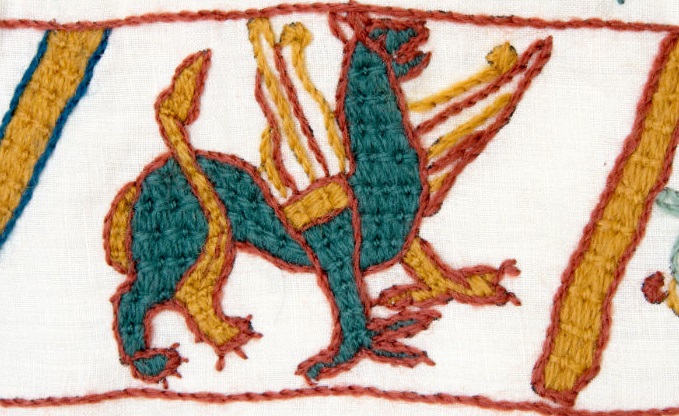Like most comic strips, the Bayeux Tapestry carries captions. True, it doesn’t have word-filled balloons coming out of people’s mouths, but it has a running commentary right across the top of the pictures, just underneath the upper frieze. Incidentally, the friezes themselves tell us a great deal too. Put them together – pictures, words, friezes – and you have a Bayeux Tapestry pretty solidly packed with information for those who have the eyes, the willingness, and the imagination to observe. Medieval scholars to this day are debating what some of it means.
And that’s not all. You would be surprised at how many features of the Tapestry still engage the attention of specialists in stitching, linen, embroidery, lettering, colours and dyes, armour, weapons, shields, geography, falconry, archery, feasts, defence and attack techniques, popes, horses, the role of women, kings, dukes, earls, carpenters, shipwrights – it goes on and on. It is a rare trade or occupation which can claim that the Tapestry holds not a scrap of information or interest for them.
Ah, well, you may say, they are all experts; we – the poor, ignorant public – can not compete with knowledge like that. It’s above our heads.
No, it isn’t. That is writing yourself off before you start.
You don’t have to compete. You only have to enjoy.
You don’t have to be an expert on a subject before you can derive knowledge, understanding, and relaxation from it. You don’t have to be a concert pianist to get a kick out of tickling the ivories.
Let’s take the words. ‘But they are in Latin.’ True; how observant of you. But how many words do you use every day which come from a language other than English? You don’t shy away from those, do you? Café, buffet, blitz, plaza, cliché, journal, commissar, spaghetti, vendetta. . . And our language is packed with words which derive from Latin.
Anyway, a good dictionary will get you over many hurdles.
Then the names – Haroldus, Willelmus, Conan, Guido, Edwardus, Normannorum, Anglorum – they won’t strain the grey cells, will they?
A little bit of deduction will help you to arrive at other answers. Look at all the pictures of ships. In the frieze where it says ‘navigavit’. It’s got to be connected with ships, and you already know the word ‘navigator’. Presto.
Similarly with words like dux, rex, arma, clericus. Look at the picture that each one goes with. You can work out ‘duke’, ‘king’, ‘arms’, ‘churchman’.
Look at some of the more dramatic tableaux. Harold setting off with his hounds and falcons. Harold, barefoot, holding his skirts up as he jumps ashore after the shipwreck. Harold getting arrested. Harold hauling those Norman soldiers out of the Couesnon quicksands. (You don’t have to be Sherlock Holmes to work out what Cosnonis means in the commentary.) Count Conan surrendering the keys to his town of Dinant. William investing Harold with the weapons of a knight. And of course the oath itself. Once again, the word ‘Bagias’ suggests ‘Bayeux’ and ‘sacramentum’can’t reasonably be anything else but the oath. Harold’s coronation can’t be anything else but a coronation. The picture of castle-building, and the words ‘castellum’ and ‘Hestenga’ don’t present much of a problem. And so on.
You may not grab it all off the bat straight away, but you will get better as you go along and get used to it. Answers will wake you up in the middle of the night or halfway through your second cup of tea. You will get smarter at guessing.
By the time you are three-quarters of the way through, something will have dawned on you: that we still haven’t reached the battle. So you will be into the secret: the Bayeux Tapestry is not very much about the Battle of Hastings.

Recent Comments